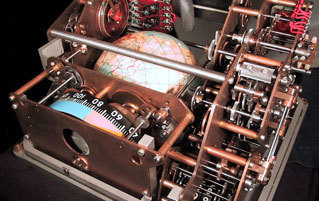4 Amazing Computers Made Before Microchips Existed

"Q1. How long does it take a mass to fall two stories under gravity?"
If you've got access to a computer (and if you're reading this you either do or you're the world's first and laziest cyborg) there are two ways to solve this problem. You can digitally calculate the answer, or you can hurl the computer out a window and time how long it takes to smash to pieces. And if you've spent any time using Adobe products, you've considered both.

"Fail to restore THIS from backups you update-sucking crashassite!"
And that still wouldn't be the most expensively stupid thing anyone has done with their computer.
Reality runs on physics equations, which means you don't always need to write them down. You could just set up something that automatically does your problem and watch what happens next. These are analog computations: instead of using abstract equations you can just build something and force the universe to do it for you. You might be surprised that physics has an option to force things, until you remember that all of physics (and therefore existence) is just forcing things.
Here are four ways we MacGyvered math out of machines without microchips.
A Globe and Some Gears Calculate Orbital Locations
When you ask yourself "Where are I?" shouting "IN SPACE!" is simultaneously the most awesome and least useful answer possible. When you're in orbit your position is a matter of life and death, and there really isn't the option of getting out and asking someone for directions -- or at least that's what the government would have us believe. In 1961 the Soviet space program answered the question by lofting the most kick-ass clockwork ever constructed.

Space age calculation.
The Globus mechanically computed the position of the Vostok and Voskhod space capsules, all the way from Yuri Gagarin up to 2002. This cosmonaut clock kicked the hell out of any cuckoo. The rotating globe wasn't just a display, it was an analog Earth used to calculate as well as indicate the craft's position. We had a spaceship rotating around the Earth, and inside it had another Earth rotating to show where it was. This was a mathematical Matryoshka doll showing off everything amazing about our species at once.

Our functional Faberge.
Even better, the Globus was mounted above the Vzor orientation device -- a window in the floor of the capsule -- so the cosmonaut could choose between looking at the clockwork planet or the real thing. And the machine worked better.
It's a clockwork masterpiece made of cardioid gears (which sound like a steampunk romance story) and more metal mathematical curves, all driven by a single actuator. As well as being the most amazing analogy ever (if a picture is worth a thousand words, a rotating planet in orbit has to be at least a trillion), output camshafts and twisting variable resistances controlled the currents to other instruments on board. This wasn't a dashboard clock: this was the ticking heart of the capsule's navigational systems. It's like if Ironman's glowy chest thing was powered by a wind-up toy from a McDonald's Happy Meal.
When the cosmonaut wanted to look ahead to the landing point, a separate motor spun the globe through time to get the desired destination. This machine had a Superman motor.

Except spacemen are better, because they have to get things right the first time.
This cosmonautic clockwork was an integral part of the space program past the turn of the millennium. So, all of steampunk: you've got a long way to go to beat what we were capable of 50 years ago. But since that's true of our actual space program, you shouldn't feel too bad.

Just try to remember that gears aren't glitter. They're meant to actually DO THINGS.
Deltar Used Electricity to Predict Floods
The Deltar computer was used in planning the Delta Works, a massive hydroengineering project and one of the American Society of Civil Engineers seven modern wonders of the world. It was designed to protect the Netherlands against the sea, tell the oceans who's really in charge of this planet, and make OCP's Delta City project look like an Airbnb rental.

The most sophisticated game of Battleship OF ALL TIME.
The Deltar looks like a regular computer, but it doesn't use any chips. It solved flooding problems by applying electricity directly. Which has to be the first thing they teach you not to do with both of those things. Electrical current is often explained in terms of water flow, and the Delta Getij Analogon Rekenmachine system reversed the polarity of that analogy by predicting water flow with electrical current. In English it's the Delta Tide Analog Calculator, and English has never felt more inferior as a language. Seriously, wherever you are, say that original Dutch name out loud. That sounds like something that could change the shape of a country.
They physically built circuits to represent Dutch waterways: capacitors storing charge to represent dams, resistors impeding the flow of electricity to act as various rivers. This is a computer for which "digital output" meant whether a spot on the output tape was punched or not, and it reshaped an entire coastline.
They went analog because that was their best option for integration. Integration means adding up all the values resulting from a function to find the total (for example, how much water will pile up and drown everybody's faces clean off). In digital calculations this means dividing the function into tiny bits and adding them all up. The more accurate you want to be, the more tiny bits you need, with the end result that perfect accuracy would take forever. With an analog computer you simply pour in charge according to the function and see how much you have at the end.

I like to unwind with some calculus.
They had an ominously named Rekenmachine, aka Deltar, full of buzzing computer banks, where people said things like, "Trigger the flood program by increasing the voltage," and it rearranged a European country. They're lucky they got through the '70s without James Bond killing them through sheer reflex action.
Kerrison Predictor Was Some Star Wars-Level Ass-Kicking (during WWII)
One math problem faced by the Allies during World War II was dive-bombers. Almost literally faced, because the bombers were diving so low and so fast that human gunners couldn't traverse the anti-aircraft guns fast enough. Meaning, not fast enough to stop them from dropping hundreds of kilograms of high-explosive. Right in the face.

Modern math exams don't apply the same kind of pressure.
The solution was the Kerrison Predictor, an analog death machine. These mechanical computers worked with camshafts and cogs carved into the shape of mathematical functions. The space-age Globus got to use electricity, because inside space capsules setting fire to flammable stuff wasn't a big priority, but back in World War II it was pretty much the entire point. The Kerrison Predictor was so huge and heaving it required its own generator. It was a camshaft computer of death, a petrol-powered, clutch-cog sky-shredder, a calculator so advanced it was constantly outputting dieselpunk band names as a mere side effect of its existence.
With the internal combustion engine humanity had worked out how to turn explosions into forward motion. The Kerrison Predictor applied that to arithmetic. We were turning explosions into our most advanced computational power, the exact opposite of what we do with consoles nowadays.

But, yeah, Call of Battle Honor is good too.
Users entered variables like wind speed and estimated target speed by turning dials, like they were setting their enemy's very last alarm clock, and if the gunner could point the gun at the plane even once the gun would take over and follow the trajectory. The Kerrison Predictor worked to predict where a plane would be and then made sure it wasn't any more. It worked so well the U.S. Army copied it to mass-produce the M5 director.

The M5 wasn't nearly as mobile as its greatest-grandson, the T800, but unlike that young whippersnapper
it could actually hit things it aimed at.
Even cooler than the calculations was how its inventors convinced the military it worked. In a demonstration to the top brass, the unit blew away a drogue being dragged behind a plane, and then took out the tow cable just to show that it could. We wouldn't be surprised if designer Major A. V. Kerrison had celebrated by getting Maria Stark pregnant.
Building a Stress Supercomputer Out of String
The Sagrada Familia looks like someone built a space station in the suburbs of heaven. It was designed by Antoni Gaudi as an astonishing fusion of natural design and intellectual ingenuity.

He must have been half dwarf, half elf. Come on, you knew Legolas/Gimli would lead to good things.
It looks like he'd worked out how to plant seeds of stone to grow a forest of soaring stone pillars and supports. Multi-member stress calculations are the sort of thing we build supercomputers for. But Gaudi solved such problems with yo-yo parts around the end of the 19th century, because LEGO blocks and anti-psychotic medications weren't a big thing back then.

"Yes, this calculation would melt the computer you're using right now."
You want all the forces in a supporting pillar to be pushing in the direction of the pillar, in compression. You don't want any shear forces shoving them sideways causing them to snap, or bending moments causing them to bow and break. You want them entirely in compression. Gaudi worked out the required angles by reversing gravity like a goddamn Time Mage.

"OK, go get 2,000 more people and we'll build the model."
The trick is that all the forces in a string are always pulling in the direction of the string, in tension. So Gaudi wove a model of the Sagrada Familia upside down. Lengths of string representing the pillars and arches, knots representing their junctions, and bags of birdshot supplying the weight. The result was a model of the entire edifice multiplied by minus one, hanging upside down at the exact angles required to rearrange the joints the right way. Dozens of simultaneous hyperbolic cosine equations solved by the same gravity they were designed to fight. He basically grabbed physics by the hand and did the ol' "Why are you hitting yourself?" bit.

Warning: DO NOT let a cat sit on this computer
It's astonishing in its simplicity, beauty, and implications. Magnificent proof of the most important truth we have: physics isn't an abstract set of equations on dusty blackboards. Physics is.
More of the most amazing things we've ever done with The 5 Coolest Things We've Ever Sent Into Orbit and 4 Plasma Technologies That Put Video Game Weapons to Shame.
For the opposite of smart, enjoy video gamers throwing away $40,000 in The 6 Most Insane eSports Scandals. Or behold the Worst Ripoffs of the World's Most Expensive Comic.
Luke has a website, tumbles, and responds to every single tweet.
